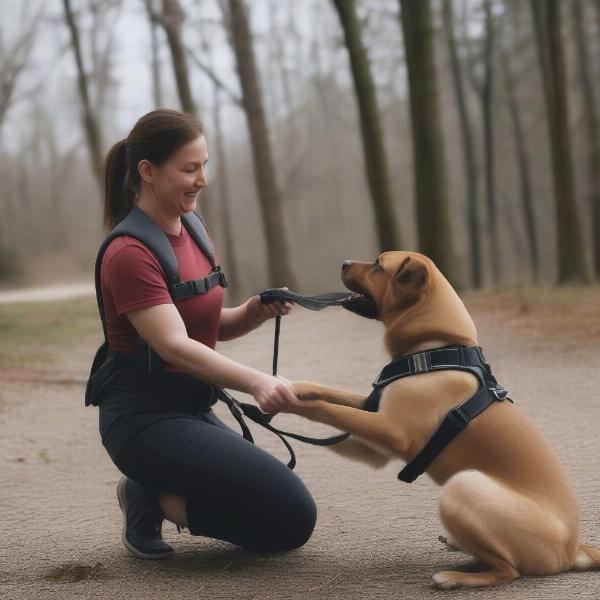A reactive dog harness can be a game-changer for both you and your dog. If your dog barks, lunges, or displays other anxious behaviors when encountering triggers like other dogs or people, a well-fitted, appropriate harness can provide better control, improve safety, and contribute to a more positive walking experience. This article will explore the different types of reactive dog harnesses, how to choose the right one for your dog, and tips for successful training.
Reactive dogs often benefit from harnesses designed to discourage pulling and redirect their focus. These harnesses generally fall into two main categories: front-clip harnesses and dual-clip harnesses. Front-clip harnesses have the leash attachment point on the dog’s chest. When the dog pulls, the harness gently steers them back towards you, disrupting the forward momentum and reducing their ability to lunge. Dual-clip harnesses offer more versatility, with leash attachment points on both the chest and the back. This allows you to switch between front-clip control for reactive situations and back-clip walking for calmer environments.
Types of Harnesses for Reactive Dogs
Choosing the best harness for your reactive dog depends on their size, strength, and specific reactivity triggers.
Front-Clip Harnesses
- Benefits: Redirects pulling force, discourages lunging, helps regain control.
- Considerations: Can cause twisting if not fitted correctly, might not be suitable for very strong pullers.
Dual-Clip Harnesses
- Benefits: Versatility, allows for both front and back clipping, adaptable to different situations.
- Considerations: Can be more complex to use initially, requires understanding when to utilize each clip.
Back-Clip Harnesses (Not Ideal for Reactive Dogs)
While readily available, traditional back-clip harnesses can actually exacerbate pulling behavior, giving the dog more leverage to lunge forward. Therefore, they are generally not recommended for reactive dogs.
Finding the Perfect Fit
A properly fitted harness is crucial for both comfort and effectiveness. A harness that’s too loose can slip off, while one that’s too tight can restrict movement and cause discomfort.
How to Measure Your Dog for a Harness
- Girth: Measure around the widest part of your dog’s chest, usually just behind the front legs.
- Neck: Measure around the base of the neck where a collar would sit.
- Length: Measure from the base of the neck to the base of the tail.
Always consult the manufacturer’s sizing chart and consider your dog’s breed and build for the most accurate fit. A dog choker chain is never a suitable alternative to a properly fitted harness.
Training Tips for Using a Reactive Dog Harness
A harness alone isn’t a magic solution for reactivity. It’s a tool that should be used in conjunction with consistent training and positive reinforcement.
- Introduce the Harness Gradually: Let your dog get used to wearing the harness before attaching a leash.
- Positive Reinforcement: Reward calm behavior with treats and praise.
- Desensitization and Counter-Conditioning: Gradually expose your dog to their triggers at a safe distance while rewarding calm responses.
- Seek Professional Guidance: Consider working with a certified dog trainer or behaviorist who specializes in reactivity. They can provide tailored guidance and support based on your dog’s specific needs. You may also consider a dog walker warrington if you are local, or a dog walker in your area.
 Training a reactive dog with a harness
Training a reactive dog with a harness
Conclusion
Investing in a reactive dog harness is a positive step towards managing your dog’s reactivity and improving your walks together. Remember that finding the right harness and consistent training go hand-in-hand. With patience and dedication, you can help your reactive dog feel more comfortable and confident in the world around them. If you’re walking multiple dogs, a dual dog retractable lead can be beneficial, however, for a reactive dog, separate leashes are recommended. Remember that a harness like this can also be useful if you have a large dog pram.
FAQ
- What’s the difference between a front-clip and a dual-clip harness? A front-clip harness has a single leash attachment point on the chest, while a dual-clip harness has attachment points on both the chest and the back.
- Is a back-clip harness suitable for a reactive dog? Generally, no. Back-clip harnesses can actually encourage pulling.
- How do I know if my dog’s harness fits correctly? You should be able to fit two fingers comfortably between the harness and your dog’s body.
- Can a harness cure reactivity? No, a harness is a management tool, not a cure. It should be used alongside training.
- What type of training is best for reactive dogs? Desensitization and counter-conditioning are commonly recommended, often combined with positive reinforcement.
- Should I use a weighted dog vest in addition to a reactive dog harness? Consult with a veterinarian or professional trainer before using a weighted vest, as it may not be suitable for all dogs.
- Where can I find more information on reactive dog training? Consult with a certified dog trainer or behaviorist specializing in reactivity.
About ILM Dog: ILM Dog is your trusted international resource for expert dog care and training advice. We offer comprehensive information on breed selection, health and medical care, training, nutrition, grooming, and much more. Whether you’re a new dog owner or a seasoned expert, ILM Dog is here to support you and your furry companion. Contact us at [email protected] or +44 20-3965-8624 for personalized guidance.